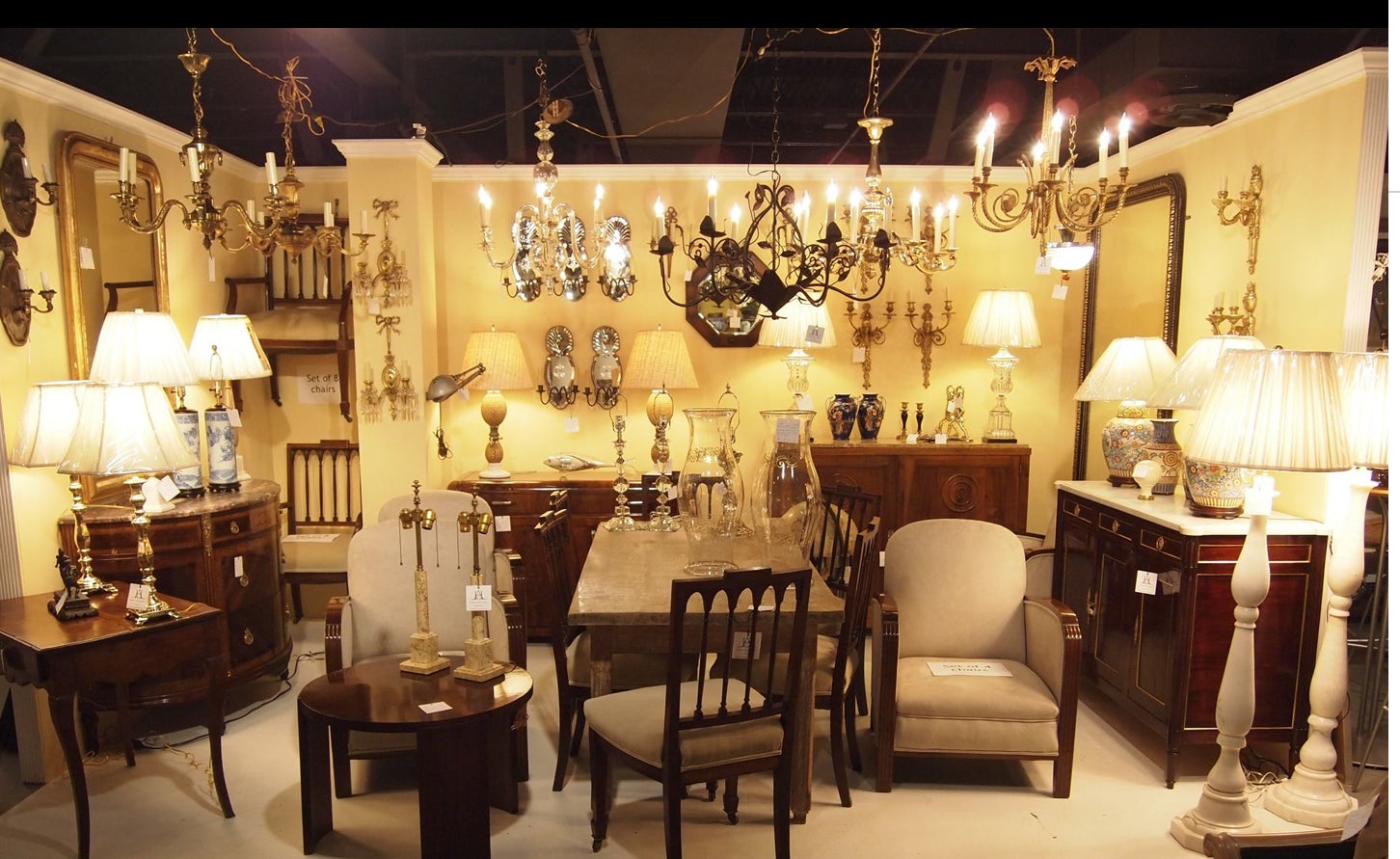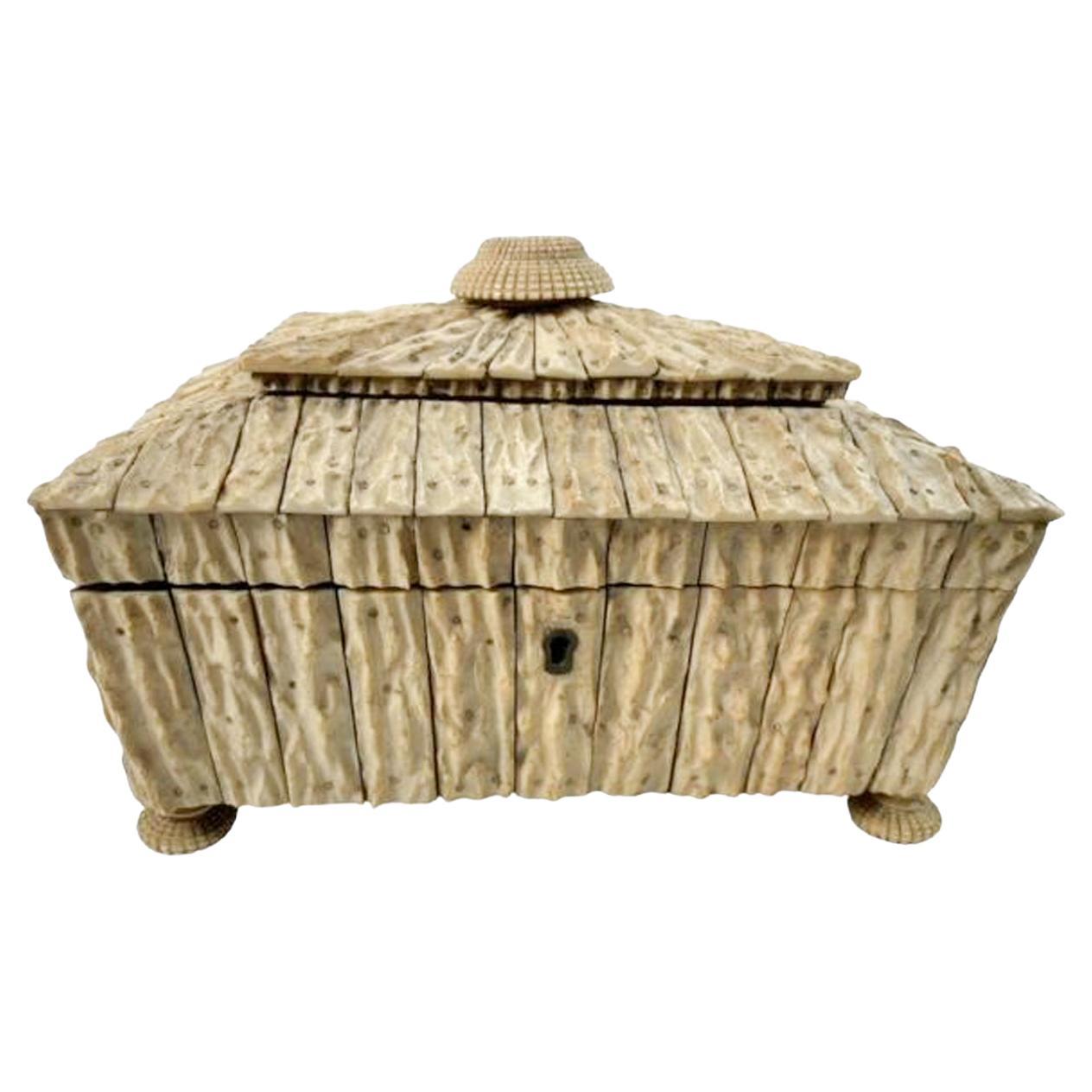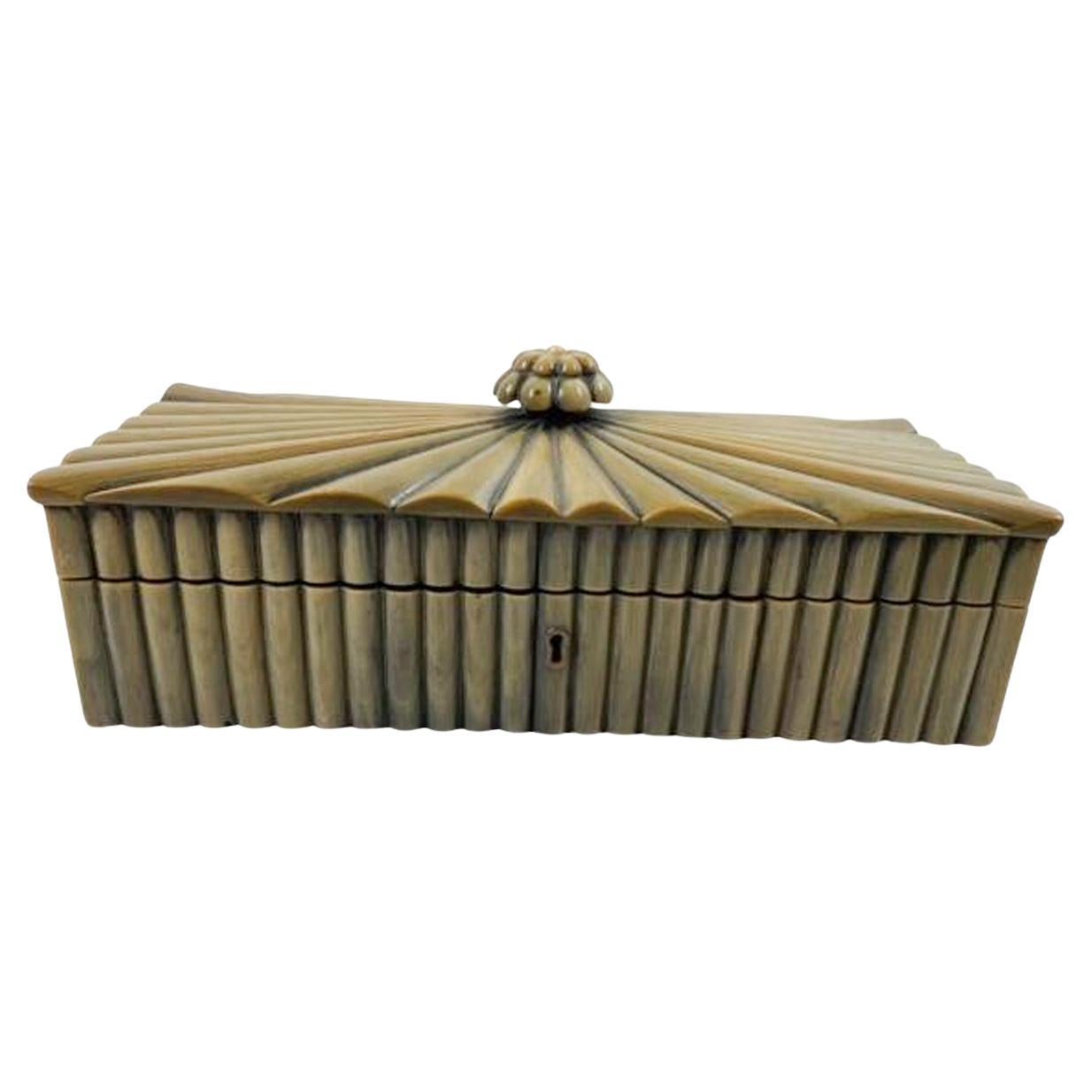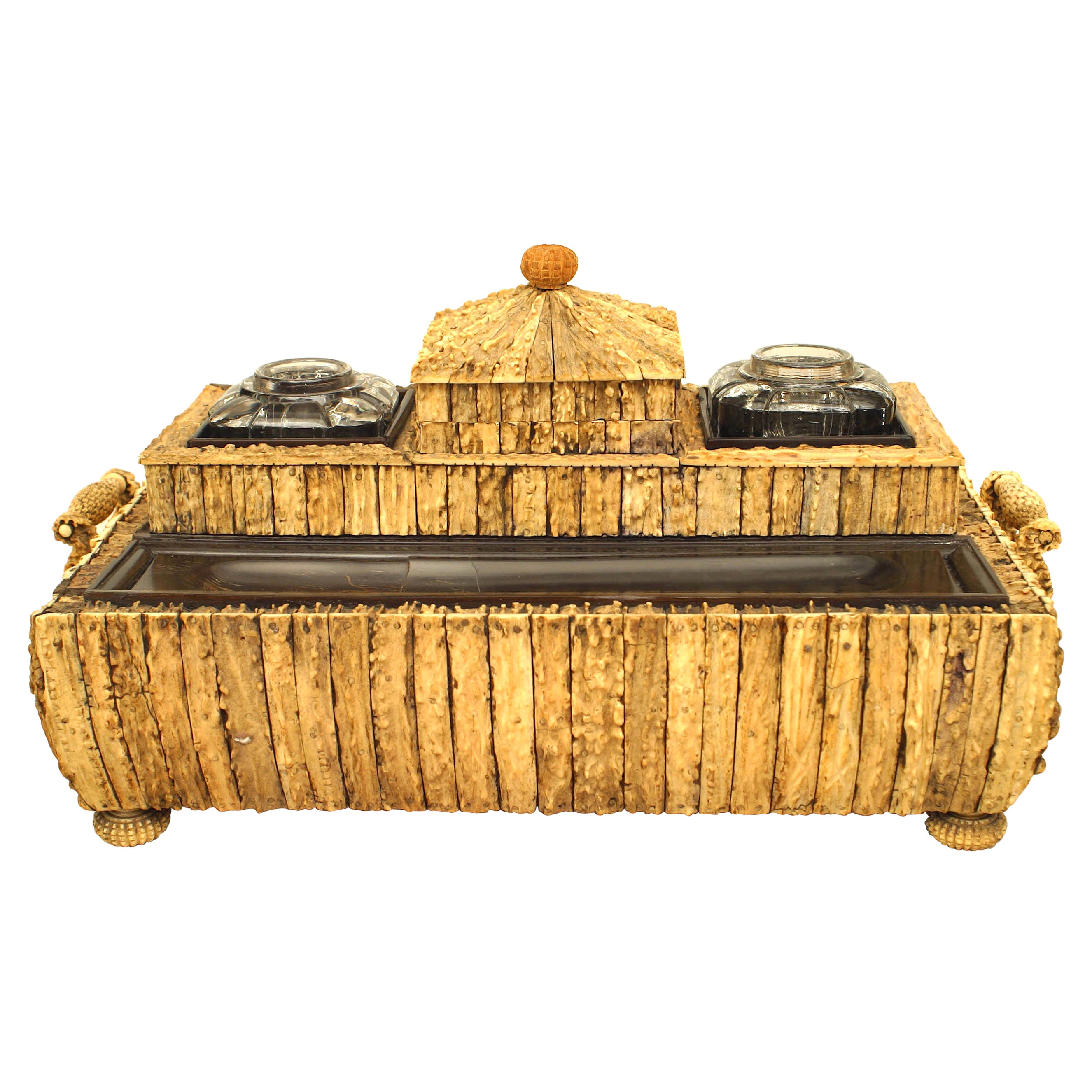Items Similar to Anglo-Indian 14"w Stag Horn Veneered Sandalwood Document/Storage Box
Want more images or videos?
Request additional images or videos from the seller
1 of 13
Anglo-Indian 14"w Stag Horn Veneered Sandalwood Document/Storage Box
About the Item
Anglo-Indian antler veneered work/storage made in Vizagapatam, of large size and having a double tiered sloped top with a large circular finial above vertically veneered sides, all raised on knurled feet. Working key present, no interior tray, lid-support hinge missing.
- Dimensions:Height: 10 in (25.4 cm)Width: 14.25 in (36.2 cm)Depth: 11 in (27.94 cm)
- Style:Anglo Raj (Of the Period)
- Materials and Techniques:
- Place of Origin:
- Period:
- Date of Manufacture:1860
- Condition:Wear consistent with age and use.
- Seller Location:Chapel Hill, NC
- Reference Number:

About the Seller
5.0
Platinum Seller
These expertly vetted sellers are 1stDibs' most experienced sellers and are rated highest by our customers.
Established in 1990
1stDibs seller since 2022
35 sales on 1stDibs
Typical response time: <1 hour
- ShippingRetrieving quote...Ships From: Nantucket, MA
- Return PolicyA return for this item may be initiated within 3 days of delivery.
More From This SellerView All
- Anglo-Indian Stag Horn Veneered Sewing / Work Box From VizagapatamLocated in Chapel Hill, NCAnglo-Indian stag horn veneered sandalwood sewing or work box with a sloped two-tier lid having a carved finial above tapered sides and raised on compressed ball feet. The interior w...Category
Antique Mid-19th Century Indian Anglo Raj Decorative Boxes
MaterialsBone, Antler, Wood
- Anglo-Indian Ribbed Horn Box with Sandalwood InteriorLocated in Chapel Hill, NCAnglo-Indian glove or trinket box from Vizagapatam of rectangular form with sloped top. Made from sandalwood with vertically ribbed horn veneered sides and starburst ribbed lid with ...Category
Antique Mid-19th Century Indian Anglo Raj Decorative Boxes
MaterialsHorn, Wood
- Anglo-Indian Horn Box with Inlaid Metal Floral Motifs Raised on Turned FeetLocated in Chapel Hill, NCAnglo-Indian box made from panels of horn and decorated with inlaid brass and white metal forming stylized flowers and borders, raised on turned horn feet. Missing four or five dots.Category
Antique Late 19th Century Indian Anglo Raj Decorative Boxes
MaterialsBrass, Steel
- 19th Century Anglo-Indian Vizagapatam Antler Veneered Sewing / Work BoxLocated in Chapel Hill, NCA fine Vizagapatam made antler veneered sewing / work box having tapered sides and a double tiered four-slope lid with a carved finial and all raised on four turned feet. The interio...Category
Antique Mid-19th Century Indian Anglo-Indian Decorative Boxes
MaterialsAntler, Wood
- 19th Century Anglo Ceylonese Porcupine Quill Box with Interior Divided TrayLocated in Chapel Hill, NCA large rectangular box made of dark hardwood inlaid with bone dots framing panels of porcupine quill. The exterior of the box is veneered with quill cut and arranged to create a zig...Category
Antique Late 19th Century Sri Lankan Anglo Raj Decorative Boxes
MaterialsBone, Wood
- Pair of Anglo Indian Silver Metal Clad Armchairs With Rams Heads.Located in Chapel Hill, NCA magnificent and striking pair of Anglo Indian armchairs adorned with intricate silver metal cladding and embellished with captivating Rams Heads motifs. These armchairs seamlessly ...Category
20th Century Indian Anglo Raj Armchairs
MaterialsMetal
You May Also Like
- Anglo Indian Sandalwood and Horn Writing BoxLocated in New York, NYAnglo Indian (19th Century) antler veneered sandalwood writing box of rectangular form with 2 glass inkwells above a drawer (Vizigapatam).Category
Antique 19th Century Anglo-Indian Inkwells
MaterialsGlass, Wood
- 19c Anglo Indian Highly Carved Padouk and Sandalwood Sarcophagus Sewing BoxLocated in Dallas, TXPRESENTING A VERY NICE 19C Anglo Indian Highly Carved Padouk and Sandalwood Sarcophagus Sewing Box. Made in Bombay, India circa 1890-1900. The box case/body is made of sandalwo...Category
Antique Late 19th Century Indian Anglo-Indian Decorative Boxes
MaterialsBone, Padouk, Sandalwood
- Regency Anglo Indian Quill Work Vizagapatam Sandalwood Sewing BoxLocated in New York, NYThis fine Regency period quill work, bone, ivory & sandalwood sewing box with intact interior w sewing implements.Category
Antique Early 19th Century Indian Regency Decorative Boxes
MaterialsBone, Sandalwood, Ivory
- 19th Century Anglo Indian Vizagapatam Carved Sandalwood Box Micro Mosaic InlaysLocated in GBWe are delighted to offer for sale this lovely 19th century Anglo-Indian Vizagapatam carved sandalwood and inlaid box Mid-19th century Anglo-Indian Vizagapatam carved sandalwood box...Category
Antique 19th Century Indian Anglo-Indian Decorative Boxes
MaterialsWood
- 19th Century Anglo-Indian Mughal BoxLocated in North Hollywood, CA19th century Anglo-Indian Mughal wood box, inlaid and hand carved with the Taj Mahal and some flowers all around. Jewelry box, Anglo-Raj box from India in great condition. Nice Mughal Bombay Box...Category
Antique Late 19th Century Indian Anglo Raj Decorative Boxes
MaterialsSandalwood
- 19C Anglo Indian Highly Carved Padouk and Sandalwood Sadeli Mosaic Sarcophagus SLocated in Dallas, TXPRESENTING A GORGEOUS 19C Anglo Indian Highly Carved Padouk and Sandalwood Sadeli Mosaic Sarcophagus Sewing Box. Made in Bombay, India circa 1860-80. Box made of sandalwood with highly carved padouk wood reliefs and panels on all sides. Edged with bone and ebony veneers and glorious sadeli mosiac, made from tiny pieces of faux ivory, pewter, green semi-precious stone. The box is in a sarcophagus form with domed lid. The original brass carry handles are on the sides. The interior is in great condition and consists of a removeable mirror under the lid portion, with the original red velvet lining behind it. The base is removeable and contains a number of lidded compartments. 6 of the interior lids on the base, are each inlaid with sadeli mosaic banding. The rest are also carved and chased. The interior is fully complete with 7 lidded faux ivory/bone, thread canisters with sadeli domes and the original bone thimble. The box sits on 4 brass ball or bun feet with the original velvet lining on the base. Some minor repairs and losses, but this box is fully complete. This is ‘rare’ as many of these boxes have not survived in such condition! Included in the sale are 2 photos that were in the box (under the base tray). Interestingly, one of them is a view of downtown Nassau, New Providence (Bermuda) from the early 20C and stamped on the rear. What a ‘journey’ this piece has made! Made in India … travelled to Bermuda, probably via Britain … back to Ireland (where we bought it) …. then to Texas! These boxes were made by superb Indian craftsmen, specifically for sale to the ruling British elite. These types of boxes, carved padouk and sandalwood, (whilst beautiful and superbly crafted) were of a lesser quality, than the more profusely and intricately mosaic inlay, tortoiseshell and ivory boxes, made for the British ‘Upper Classes’ in the areas of Bombay and Vizagapatam. These type of boxes were much more affordable back in 1880 (and indeed today) and would probably have been bought by mid-level diplomats, civil servants or visitors. Sewing boxes (in general), were in EVERY Victorian home in Britain in the 19th Century and like other boxes etc were ‘status symbols’ of your place in society! The more ornate the box, the more ‘Upper Class’ you were! Of it’s type, this one, is one of the very higher quality one’s, than the norm! SADELI MOSAIC: “Anglo Indian boxes were made in India for the English residents from the early part of the 18th century. They were brought back or sent back to England usually by the people who had commissioned them. From the beginning of the nineteenth century they were imported more commercially, although not in any significant numbers until the middle decades. They were very highly valued, especially the early ones, to the extent that the designs were copied on late 19th and early 20th century tins. The ancient art of Sadeli Mosaic is said to have been introduced from Shiraz in Persia via Sind to Bombay, a long time before the Anglo Indian boxes were made. It was a technique, which required a high degree of skill and patience. It was executed very lavishly, in that the frequent cuts wasted a great amount of the precious materials used. The workmanship was however more than commensurable to the value of the materials. Ivory, silver, pewter (or other metals), wood and horn were cut into faceted rods which were bound together to form geometric patterns. When the glue has set, the rods were sliced in transverse sections. This gave the maker a number of angled circular pieces in the original pattern. Several variations of patterns could be achieved by combining the materials in different ways. The ivory was sometimes dyed green to give an extra color. The mosaic pieces in a combination of patterns, often separated by ivory, ebony, horn or silver stringing were used to veneer sandalwood boxes. In the early boxes, which date from the turn of the 18th to the 19th century, there are large panels of mosaic covering tops and sides of boxes. It took incredible skill to cover such large areas without any shakes or wavering of the pattern. The corners and joins on these boxes are impeccably matched. The makers (reputed to be Persian) of Sadeli mosaic made in the first two decades of the 19th century displayed a total understanding of the qualities of the different materials they used. They combined substances, which can expand and contract according to atmospheric conditions with others, which are hard and unyielding. The result was a sharp definition of the lines and patterns, which made up the whole design. On the early boxes the designs look deceptively simple. The fact is, they emerged from a culture, which had mastered geometry and understood how to generate a pattern from a set number of points. The patterns are so harmoniously combined that their incredible complexity is not immediately apparent. The earliest Sadeli boxes...Category
Antique 19th Century Indian Anglo-Indian Decorative Boxes
MaterialsBone, Padouk, Sandalwood





